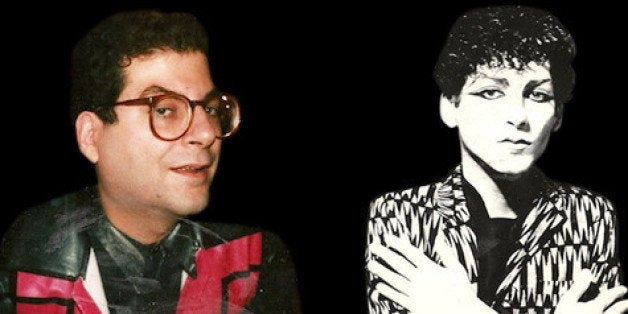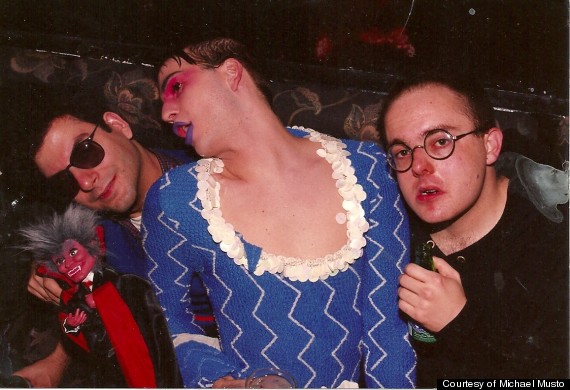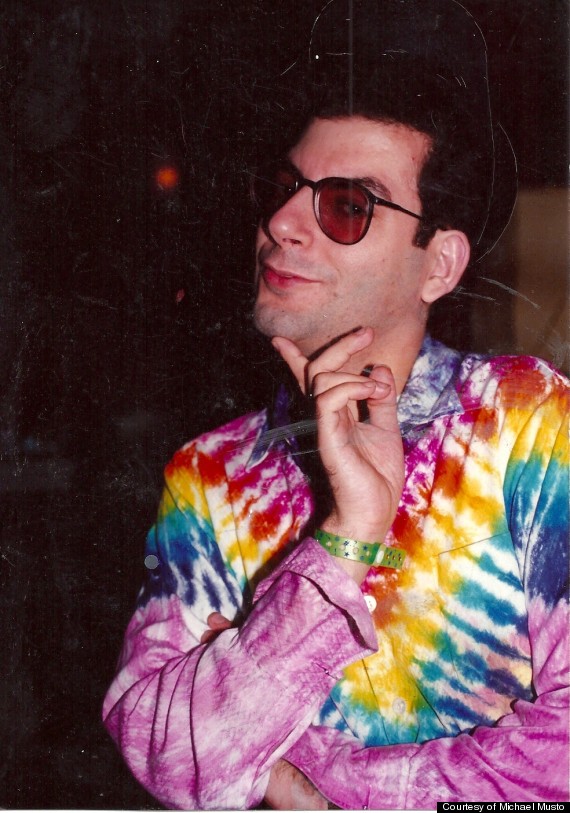
This is the seventh installment in HuffPost Gay Voices Associate Editor JamesMichael Nichols' 30-part series "After Dark: NYC Nightlife Today And Days Past" that examines the state of New York nightlife in the modern day, as well as the development and production of nightlife over the past several decades. Each featured individual in this series currently serves as a prominent person in the New York nightlife community or has made important contributions in the past that have sustained long-lasting impacts.
HuffPost Gay Voices believes that it is important and valuable to elevate the work, both today and in the past, of those engaged in the New York nightlife community, especially in an age where queer history seems to be increasingly forgotten. Nightlife not only creates spaces for queers and other marginalized groups to be artistically and authentically celebrated, but the work of those involved in nightlife creates and shapes the future of our culture as a whole. Visit Gay Voices regularly to learn not only about individuals currently making an impact in nightlife, but those whose legacy has previously contributed to the ways we understand queerness, art, identity and human experience today.
The Huffington Post: Talk to me a bit about how you made your entry into NYC nightlife in the 1970s and your early days writing about the scene.
Michael Musto: Well, I went through Columbia College at Columbia University and was very young -- I entered at age 16. But eventually I started being dragged to different mixers and things of that sort. By the time I got out in 1976 I had a real taste for nightlife. By the time the ultimate disco -- Studio 54 -- came around I was writing for the SoHo Weekly News, which was an alternative weekly at the time. And so I got entrée by Steve Rubell himself, the co-owner, into Studio 54 -- the most legendary, eye-popping, spectacular nightclub of all time. I pretty much started at the top. I would go from there to the Mudd Club, which was in the then-wastelands of Tribeca. That was like the anti-Studio 54. It was a divey, rock n' roll place full of haughty people in skinny ties. It was kind of the antithesis of the glitz and the spectacle of 54.
I had a great time running back and forth between both worlds and just found nightlife immediately the place where LGBT people could find a home. A lot of people who had been bullied in their hometowns or rejected by their parents suddenly found a family -- however dysfunctional -- within the nightlife, which accepted you for your differences or eccentricities, individualities and special talents. Right away I felt like this was a great home for me. This was where I belonged.
How did that segue into becoming a cultural critic about nightlife and celebrity culture?
I was always a writer. So being attracted to nightlife it made sense that I should write about it. By 1984 The Village Voice was looking for a columnist, mainly for celebrity gossip. But because I had my finger on the pulse of clubs, that was also very integral -- the '80s scene of large clubs, large-scale lavish expenditure on bohemia, which might sound like a contradiction but it was a time of what you would call celebutantes. In other words, bohemian outrageous club people who also wanted to be tremendously famous and were catered to by these large clubs like Area and Limelight, which had enormous budgets to celebrate bohemia. Since I was already immersed in that it made sense for me to include it in my column at The Village Voice. I always found, as a cultural critic, that the clubs were the places where a lot of the trends were breaking, whether it be music, fashion, art -- it’s where it all came together culturally. Things that we were celebrating at Limelight, let’s say, were things the rest of the country would be catching up with three years later.

How integral were you to the Club Kids scene in the late '80s and early '90s?
I was very integral to that. I was the first one to write about Michael Alig and the Club Kids when I saw that he was a rising force within the clubs. And Michael was smart and savvy enough to know that I was the person to cater and nod to as the person who was documenting everything that went on in New York nightlife. So he would put me on all of his different invites and I would tell my readers what happened without ever drawing the line at the bad stuff. I would openly chastise him and became kind of an elder statesman/critic of the Club Kid scene. I would celebrate what was good about them on the talk shows with them because they were up against all of these puritans saying they were the devil and the end of civilization. And I would say no, this is actually a good place for a young gay person to come of age in many ways. But I would also chastise Alig when he went too far and when his brattiness turned into real destructiveness. And he never minded -- I never had to worry about what I wrote because he never cared as long as you spelled his name right.
That’s interesting because I wanted to talk about the way your work has shaped public perception surrounding nightlife over the years. Do you feel a kind of responsibility for the way the Club Kid era is historically framed?
I do because most of my readers don’t go to clubs at all. They look to me as their entrée into nightlife. They would rather sit back and read about it through my eyes and through the years have come to trust my point of view on everything. So I do feel very responsible for relaying what is going on to a mass audience -- from a very inside point of view and funneled through my intelligence and my perception. So yeah, I think my point of view has been pretty integral to the way people perceive nightlife and I always make a point of celebrating gay nightlife even when I’m criticizing what’s wrong with it.

Has changed at all over the years? That is, the way people perceive your role within nightlife and the dissemination of information?
Well, now there’s the Internet, now there’s Yelp, now everyone has a blog, everyone has a point of view on Facebook. So the entire world is a nightlife columnist or a critic -- but how many are really in the trenches every night like I am? And how many of them have my particular vision? They don’t. They have their own vision, which is wonderful, but I’m literally out there checking out new trends, catching up with the old, celebrating new stars on the scene and very few people my age would have the energy to do that -- but I do.
You’ve been hosting parties and writing about nightlife for decades by this point -– why are you still doing it?
I’m drawn to this scene. It’s something that you always find yourself wanting to be part of because it’s a scene that celebrates people for their gay sexuality, bisexuality, transgender identity and all of the different aspects of the rainbow. And it elevates you for being different.
Growing up I was always self-conscious that somebody was going to pick on me or I didn’t quite belong. I really didn’t get bullied that much; it was more the sense that I knew I was different and wasn’t certain how I was going to fit in within the world. But there are no such doubts in the club world. Ever since the '70s when I started being part of the feast of nightlife, I’ve felt welcomed and felt that even if I don’t look like Zac Efron or have the personality of a talk show host that people are happy to see me. Not just because I can give them mentions but because they respect the years that I’ve applied to the scene and my dedication to it.

I want to read you a quote from Walt Cassidy’s "After Dark" feature: “The nightlife experience today is no longer linear. It is broken up into two parts. The participation, which largely consists of documenting the experience, followed by the process of offloading it into cyber space and having a secondary experience online.” Do you agree with this? How do you feel like technology and the Internet have augmented nightlife in the modern day?
Too much about being in a club is about people wanting to share bragging rights that they were there. So they have their phone up in the air documenting some drag performance. And I guess they figure they’re going to watch it later when they post it on YouTube. I’d rather watch it when I’m there -- that’s the whole point of being there! But I don’t find it that detrimental to the point of devastating the scene. I think it’s just one of those nuisances, like people who get too drunk or coat checks that cost too much. It’s just the way things are today and it’s still worth leaving the house to interact with people because you are going to find interaction.
The people who are going out to a bar or club basically want to be there more than just to document it. It’s just that the era of the large dance club is gone and might never come back. Between Mayor Giuliani’s crackdown, which was continued by Bloomberg, combined with the enormous power that was being wielded by the community boards and the way nightlife was being portrayed as the evil stepchild that needed to be sent to the back of the bus, it’s really hard to open a large dance club today. And I’m afraid that the younger generations has lost the talent of even wanting to dance. It’s not like bike riding -- it doesn’t just come automatically. So that’s one thing that’s changed that might never come back -- gay nightlife in New York is more about the intimate bar with the drag show than it is so much about a big, dance euphoric event.
The economics of throwing a club party are also enormous nowadays. People can’t even take a risk anymore -- that's why you’ll see 12-18 different promoters on an invitation because they’re trying to draw in all of these different lists. Combined with what we were speaking about as to the Internet and their phone apps -- people just don’t want to go out as much anymore. So it’s hard to throw a successful large dance party. Fortunately there was Viva on Saturdays at Stage 48, there’s Berlin Fridays at Providence, which is more of a medium-sized party. But the '80s days of Area, Palladium and Danceteria with floors upon floors and ambiances upon ambiances filled with mixed crowds in many instances -- it’s going to be hard to get that all back. It’s just not right for this moment.
I kind of feel like we just saw that with Liberty Saturdays. They tried to make something along the scale of a mega-club happen and it lasted about five or six weeks.
Yeah. And they tried for some kind of mixed crowd which the gays were not ready for.
I don’t think it meshed quite the way they thought it was going to.
They ran for the doors screaming [laughs].
Well, do you feel like what you see happening in New York nightlife today as consciously building on a historical legacy of artists, performers, musicians and personalities? Or do you feel like there’s a certain amount of erasure of queer history that takes place?
I feel that even under the modern strictures of everyone having to behave themselves and looking behind their backs to see who is watching, nightlife still thrives as a celebration of the underdog, the avant garde, the performer, the drag queen. Nightlife is all about rebellion and celebration of the underground. And the more you push it down the more they’re going to bounce back and fight against the oppression.
As for the history, there are a lot of kids who have never heard of anything past two years ago -- they don’t even know about Britney Spears’ early period! And I’m not mad at them for that. I’m not Larry Kramer screaming about how dumb the kids are because I don’t think they are dumb. As long as they exhibit an interest in learning, I’m OK with that. If they have a curiosity, if they’ll do a Google search, if they’ll come to me and ask about the past, if they’ll pick up a book or an old column of mine that shows a certain interest and enlightenment. But I know when I was 20 I certainly didn’t want to hear about Stonewall or whatever speakeasy existed in the 1930s before Stonewall.

What do you think is the most important thing to come out of what nightlife has shifted and developed into today?
[after a lengthy pause] It’s hard when you think of the glory days that I’ve lived through. I mean, one good thing about the horrible economic crunch that’s hurt everyone’s lives and nightlife is that you don’t find as many messy people in clubs annoying you and having to be thrown out at closing time. Most people are fully together; they’re going to a club or bar for a specific reason. They’re enjoying themselves for that period in time, they’re going home and they’re going to wake up and go to the gym or go to their job or whatever. So I find there’s a lot more self-composure than there used to be. I’m not necessarily saying that’s a good thing because, you know, having a methy rock star vomit on your lap or something can be interesting [laughs]. I just find the Club Kids, for example, today are much more self-possessed, confident, have a mission, they’re ethical, they’re legal, they have day jobs and they just have an enormous talent for dressing up that doesn’t really spill over into the amoral or the outlandishly unreal. I mean, thank god we still have the spectacle, we still have fabulous fashionista types that will illuminate a party with their clothing. But they don’t have the horrifying behavior that can go with that at times.
What publications and gigs are you currently engaged with?
I have a weekly column “Musto! The Musical!” on Out.com every Monday. I’m blogging at papermag.com, which is Paper Magazine’s website. Theblot.com, which is a very fun sassy, sarcastic website. Also The Daily Beast, the style section in the New York Times and everyone else who asks me. I'm also a host on the roof at The Standard on Tuesdays for Susanne Bartsch’s “On Top.”
If there was something you wished to communicate about the evolution of queer history through nightlife in New York to the new generation, what do you think is the most important thing to emphasize or ensure is not forgotten?
I would want the kids to know that even though we assume things must have been horrible for gays in the past, that’s not 100 percent the case. When it came to nightlife in the 70s, for example, to me it was the peak of gay nightlife. It was a fabulous time to be gay in New York City. Sure, things like "Don’t Ask Don’t Tell" or gay marriage weren’t on the table -- they weren’t even conceptually thought of as ideas yet. But beyond that if you were fairly affluent and doing well, you had a hell of a time being a gay New Yorker. The clubs, the bars, the opportunities were enormous and it was just a wonderful celebratory post-Stonewall time of exploring different freedoms.
Missed the previous installments in this series? Check out the slideshow below.
